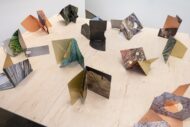Comments/Context: When Letha Wilson first emerged on the contemporary photography scene more than a decade ago now, she arrived at moment when the power of digital printing was just being understood, and artists were leveraging the fact that digital imagery could be printed on just about anything, leading to an entire wave of experimental photo-based objects. Wilson’s own early photo-sculptures were never entirely rooted in that digital idea, but her work was nonetheless swept along in that larger trend.
In the years since, she has continued to explore the possibilities of combining photographic imagery with spatial physicality, in a progression of innovative sculptural forms. Starting with textural images of nature (including leafy jungles, evergreen mountains, rocky deserts, and a few moonrises), she has made fans and folds, interrupted the images with concrete and wood dowels, affixed them to steel plates and created curves, bends, and interventions in gallery spaces, used cut throughs and arced edges to introduce geometric shapes, and generally played with the fluid intersection of natural and man-made materials. Wilson has also smartly re-interpreted some of these aesthetic learnings in book form, using paper stocks, folds, cuts, and other physical construction features to adapt her ideas to the scale and intimacy of something smaller than room sized.
This show brings together a selection of new works, all built using the same elemental structure. Each is made from a single color photograph, often cropped down to center our attention on the patterns and surfaces found in palm leaves, frozen grasses, rock walls, and desert arroyos. These images have then been divided into four rectangular sections and mounted on brass, copper, or steel (with attention to the matching tonalities between the images and the substrates). Fabric hinges connect the four plates in each structure, allowing them to bend and fold back on themselves (depending on where the hinges are placed), with the image on one side and the exposed metal on the other of each panel. And Wilson has then gone further to cut various plates, removing angled or curved sections, opening up small or large circular perforations, and adding in thin slits that let light through.
Wilson’s experience with bookmaking seems to have inspired these modestly-sized efforts, as each one can be unfolded to lay flat like a poster made from four sheets of standard sized 8 1/2 x 11 inch paper. As seen in the installation shots, several of the works have been hung directly on the wall in this manner, or with certain elements folded down or interleaved like flaps, thereby reaching out from two dimensions into three. But most of the works have been allowed further degrees of freedom to present themselves, taking shape as planes that twist and tangle in seemingly infinite variety. And when finished with their expressive walking and bending, they can each be folded up and plausibly placed neatly in a thin briefcase, with a nod to the pandemic-era and its more solitary modes of creation and interaction.
Given the physical possibilities provided by Wilson’s chosen sculptural infrastructure, her image choices then create another layer of relationships. Pictures of palm fronds, ferns, and dry/frozen grasses all feature repeated striping and line patterns, which can then be echoed by cuts or reoriented by the hinged bending. Up close crops of rock faces and dusty desert offer crumblier all-over textures, and alternate opportunities for color matching with the golden and bronze colored metals. In a few cases, Wilson introduces a horizon line and washes of sky, which she then interrupts with arcs and perforations, the largest circles turning into hovering moons in the deep blue of the twilight. And there’s even one self-portrait, via a shadow cast on a rocky ledge, the angle of the edge repeated in a slashing cut.
“Activation” isn’t usually something to think about much in the realm of photography, but in these works, the bending and folding undeniably activates the imagery, transforming flat geometries in 2D into fuller, space-shaping geometries in 3D. When reconfigured, the photographs are elegantly and ingeniously re-imagined, offering alternate orientations, overlaps, see-throughs, echoes, and intersections, with the negative space (and the metal backs of the panels) becoming active design elements. When folded and displayed as sculpture, the works have a sense of implied movement, with alternate possibilities and configurations, like those found in a magic snake puzzle, just a few folds away.
Wilson has gotten the balance between simplicity and complexity just right in these new works, which is likely why they feel so engaging and approachable. I could hardly resist picking up and reconfiguring each and every one of the works on the plywood pedestal, if only to see how they looked in alternate arrangements. That essential creative flexibility bodes well for their durable interest, as each work is really many, each understated fold (and re-fold) offering the possibility of discovering something unexpected.

